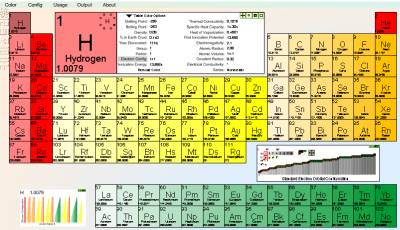What are the many patterns that exist in the periodic table of elements that celebrated the 150th anniversary?

by Larry
" Periodic Table " is a table in which elements , which are basic units constituting substances, are arranged such that their physical or scientific properties are similarly aligned. The periodic table, which was invented by Russian chemist Dmitri Mendeleev in 1869, will celebrate 150 years since its birth in 2019. The Conversation of academic media summarizes the history of such a periodic table and various periodic chart patterns which are slightly different from the generally known periodic table.
The periodic table is 150 - but it could have looked very different
https://theconversation.com/the-periodic-table-is-150-but-it-could-have-looked-very-different-106899
There should be something many people saw about the periodic table which is stuck on the wall of the science room or posted at the end of the textbook. Although Mendeleev is said to have produced such a periodic table for the first time, in fact it has tried and error to create a table in which many chemists arranged atoms arranged before Mendeleev.
A few decades before Mendeleev produced a periodic table, John Dalton , a British chemist, attempted to create a periodic table, but this challenge has failed. Also, a few years before Mendeleev's periodic table is made, John Newlands , a British chemist as well as Dalton, arrange the elements in atomic weight order and elements with properties similar to every eighth are placed " Octave 's Law "is advocated.
Then, what Merdeleev's periodic table produced was superior, it seems that it was "a part missing in the table". In contrast to Dalton and Newlands trying to arrange the elements found at the time of creation cleanly, Mendeleev said in the periodic table "a space that is not discovered at this time, but probably will be present" space It was vacant.
This is Mendeleev's periodic table. For unknown elements, they are filled with "?" Marks and their element quantities are also described.

In the Mendeleev periodic table, the bottom of " Zn (zinc) " is empty, and Mendeleev predicted the nature of this unknown element "atomic weight is 68, density of 6 g per cubic centimeter, melting point is very low" That's right. And six years after Mendelayev's prophecy, we discovered a gallium with an atomic weight of 69.7, a density of 5.9 g per cubic centimeter, and a melting point of 29.8 degrees by French chemist Paul Boerboardborn .
Mendeleyev also conducted similar prophecies about elements such as scandium and germanium , so the discovery of unknown elements has confirmed the correctness of Mendeleev's periodic table.
At first glance, Mendeleev's periodic table looks like a totally different one from the currently used periodic table. This is due to the fact that the group of noble gases (Group 18 elements) that Mendeleev had missed is not described, and that the Mendeleev table is currently in a state where the general periodic table is inclined to the left by 90 degrees Thing. This is a general period table.

In fact, various periodic tables have been invented by chemists besides the periodic table many people have become familiar with. For example, Heinrich Baum Hauer, a German chemist, has invented a periodic table that depicts a strange spiral. Hydrogen is placed at the center and atomic weight increases as going outward from the center, and atoms arranged on the same spoke extending from the center to the outer circumference have common properties.

By the beginning of the 20th century it seems that the periodic table has settled in the form currently used, and in 1905 the noble gases that Mendeleev had missed came on the far right. Meanwhile, it seems that the creation of a new periodic table was also carried out in part, and Charles Janet who was a French chemist has created the " left step period table " based on quantum theory . The periodic table created by Janet has been favored by many physicists up to now, and in spite of the fact that up to 92 atoms were only found at that time, the space to the 120th atom was also opened It is interesting.

As a matter of fact, the current periodic table has a large aspect of developing Janet's periodic table, and it is due to Janet's discovery that elements are classified into several types ( element blocks ) on the periodic table. Since the periodic table does not fit well on the paper if it is written exactly, the lanthanoid elements and actinoid elements which are F block elements are shown separately below the table.
The movement to seek out the creation of a clean periodic table still continues, and a three-dimensional periodic table ... ...

A periodic table like a train route map has been devised.

Also, arranging beer types as a periodic table ......

Or playing such as arranging Disney characters in the periodic table, etc., the periodic table seems to be firmly rooted in the minds of people.

Related Posts:







